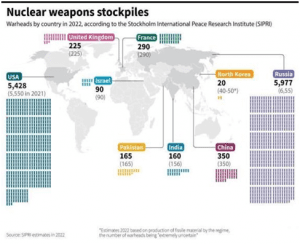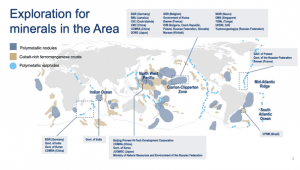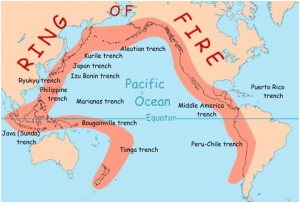THE CONTEXT: On February 23, on the eve of the first anniversary of his country’s “special military operation” in Ukraine, Russian President Vladimir Putin announced that Moscow was unilaterally suspending the last remaining nuclear arms control treaty with the US This article analyse various aspects related to the arms control and disarmament and Implications of India
WHAT IS START TREATY?
New START treaty is a nuclear arms reduction treaty between the United States and the Russian Federation with the formal name of Measures for the Further Reduction and Limitation of Strategic Offensive Arms. It was signed on 8 April 2010 in Prague,and after ratification, it entered into force on 5 February 2011.
The treaty is the 7th in a series of bilateral agreements between the USSR/Russia and the US to limit strategic nuclear weapons.
WHAT IS COMMITMENT IN THE START TREATY?
- Under the Treaty, America and Russia cannot deploy more than 1,550 strategic nuclear warheads and more than 700 long-range missiles and bombers. It also limits each country to 800 deployed and non-deployed launchers and delivery vehicles.
- The treaty calls for halving the number of strategic nuclear missile launchers. A new inspection and verification regime will be established, replacing the SORT mechanism.
- Monitoring and verification is one of the core tenets deliberated between the United States and the Russian Federation. When New START entered into force, both participating states could begin performing inspections on each other.
EVOLUTION OF NEW START TREATY
Strategic Arms Limitation Talks-1(SALT)
It began in 1969; under the Interim Agreement, both sides pledged not to construct new Intercontinental Ballistic Missile (ICBM) silos, not to increase the size of existing ICBM silos significantly, and capped the number of Submarine-Launched Ballistic Missile (SLBM)
Strategic Arms Reduction Treaty-1 (START)
The Strategic Arms Reduction Treaty (START I), signed in 1991, was a bilateral arms control treaty between the United States and the Soviet Union. The result of the agreement was the first significant reduction in the number of strategic nuclear weapons in both the US and the Soviet stockpiles. It entered into force in 1994, after the Soviet Union’s dissolution, and eventually expired in 2009.
Anti-Ballistic Missile Treaty (ABM Treaty or ABMT)
It was an arms control treaty between the United States and the Soviet Union on the limitation of the anti-ballistic missile (ABM) systems used in defending areas against ballistic missile-delivered nuclear weapons. It was intended to reduce pressures to build more nuclear weapons to maintain deterrence. Under the terms of the treaty, each party was limited to two ABM complexes, each of which was to be limited to 100 anti-ballistic missiles.
Signed in 1972, it was in force for the next 30 years. In June 2002, the United States withdrew from the treaty, leading to its termination, citing risks of nuclear blackmail.
Strategic Arms Reduction Treaty-2
It was envisaged to further reduce the missiles and warheads. Signed in 1993, called for banning the use of multiple independently targetable re-entry vehicles (MIRVs) on intercontinental ballistic missiles (ICBMs).
It was ratified by the US Senate on 26 January 1996 and Russia ratified START II on 14 April 2000, making it conditional on preserving the ABM Treaty. When the US withdrew from the ABM Treaty on 13 June 2002, Russia withdrew from START II one day later.Thus, START II never entered into effect.
INF Treaty
The Intermediate-Range Nuclear Forces Treaty (INF) was signed on December 8, 1987, and entered into force on June 1, 1988.
The treaty required parties to eliminate nuclear and conventional ground-launched ballistic and cruise missiles that are used at distances ranging from 500 to 5,500 kilometres.
The two countries eliminated intermediate-range nuclear weapons by 1991, destroying a total of 2,692 missiles.
After the disintegration of the Soviet Union in 1991, the treaty was “multilateralized” to include 12 Soviet successor states.
On August 2, 2019, the United States officially withdrew from the INF treaty. President Trump cited Russia’s noncompliance by developing and fielding a treaty-violating missile system as the reason for leaving.
Strategic Offensive Reductions Treaty (SORT)
Against the backdrop of START II (Strategic Arms Reduction Treaty) treaty, SORT was signed in 2004, under which the United States and Russia reduced their strategic arsenals to 1,700-2,200 warheads each.
New Strategic Arms Reduction Treaty (START)
New START replaced the Treaty of Moscow (SORT), which was to expire in December 2012. It follows the START I treaty, which expired in December 2009; the proposed START II treaty which never entered into force; and the START III treaty, for which negotiations were never concluded.
WHY IS START SUSPENDING – RUSSIA’S VIEW?
- Russia claims that there is an asymmetry of strategic weapons forces between Russia and the North Atlantic Treaty Organization (NATO). It highlighted that the US is not the only nuclear weapon country in NATO, but that France and the United Kingdom are also nuclear weapon countries. While the New START was a bilateral treaty, Russia faced a threat from the entire NATO having more than one nuclear state.
- Russian President also accused the US of rejecting some Russian requests for visits to specific US facilities.
- Russia said the North Atlantic Treaty Organisation (NATO) and the US wanted to “inflict ‘strategic defeat’ on it and “try to get to our nuclear facilities at the same time.”
WHAT IS A DISARMAMENT REGIME?
Disarmament agreements usually directly prohibit the possession or production of weapons.
DIFFERENCE BETWEEN DISARMAMENT AND ARMS CONTROL
- Arms control aims to limit the number of weapons and to regulate their use by virtue of bilateral or multilateral agreements or arrangements.
- Arms-control agreements often proceed by setting limitations on the testing, deploying, or using certain types of weapons.
- Disarmament, on the other hand, aims at the elimination of entire weapon system categories. The spread of weapons of mass destruction (WMDs) poses a serious threat to international security.
DISARMAMENT REGIME
- Since the birth of the United Nations, the goals of multilateral disarmament and arms limitation have been central to the Organization’s efforts to maintain international peace and security.
- The UN has given highest priority to reducing and eventually eliminating nuclear weapons, destroying chemical weapons, and strengthening the prohibition of biological weapons – all of which pose the direst threats to humankind.
- Through global efforts, several multilateral treaties and instruments have been established with the aim of regulating, restricting, or eliminating certain weapons.
- These include:
- Treaty on the Non-Proliferation of Nuclear Weapons,
- Comprehensive Nuclear-Test-Ban Treaty,
- Treaty on the Prohibition of Nuclear Weapons,
- Biological and Chemical Weapons Convention,
- Anti-Personnel Landmine Convention,
- Convention on Cluster Munitions,
- Convention on Certain Conventional Weapons and
- Arms Trade Treaty.
NUCLEAR DISARMAMENT AND NON-PROLIFERATION
- Nuclear weapons are the most dangerous weapons on earth. One can destroy a whole city, potentially killing millions, and jeopardizing the natural environment and lives of future generations through its long-term catastrophic effects.
- Nuclear weapons are the most dangerous weapons on earth. One can destroy a whole city, potentially killing millions, and jeopardizing the natural environment and lives of future generations through its long-term catastrophic effects.
- Several multilateral treaties have since been established with the aim of preventing nuclear proliferation and testing while promoting progress in nuclear disarmament. These include:
- Treaty on the Non-Proliferation of Nuclear Weapons (NPT),
- Treaty Banning Nuclear Weapon Tests In The Atmosphere, In Outer Space And Under Water, also known as the Comprehensive Nuclear-Test-Ban Treaty (CTBT), which was signed in 1996 but has yet to enter into force, and
- Treaty on the Prohibition of Nuclear Weapons (TPNW).

Missile proliferation: Presently, several multilateral regimes exist which seek to prevent the proliferation of missiles and related technology. These include, notably, the Hague Code of Conduct (HCOC) and the Missile Technology Control Regime (MTCR).
Biological Weapons:
- Biological weapons disseminate disease-causing organisms or toxins to harm or kill humans, animals, or plants. They can be deadly and highly contagious. Diseases caused by such weapons would not confine themselves to national borders and could spread rapidly around the world.
- The Biological Weapons Convention (BWC) effectively prohibits the development, production, acquisition, transfer, stockpiling and use of biological and toxin weapons. It was the first multilateral disarmament treaty banning an entire category of weapons of mass destruction (WMD).
Chemical Weapons : Conclusion of the Chemical Weapons Convention in 1993, aims to eliminate an entire category of weapons of mass destruction by prohibiting the development, production, stockpiling, transfer and use of chemical weapons; to prevent their re-emergence; to ensure the elimination of existing stocks of such weapons; and, in so doing, to make the world safe from the threat of chemical warfare.
Arms Trade: Arms Trade Treaty (ATT) was adopted in April 2013 by the General Assembly of the United Nations. Before the adoption of the ATT, there was no global set of legal rules governing the trade in conventional weapons. The treaty sets robust international standards to help guide governments in deciding whether or not to authorize arms transfers. It provides for cooperation and assistance to help countries develop adequate regulatory systems and safe weapons stockpiles.
WHY WILL IT BE A THREAT TO THE DISARMAMENT REGIME?
The core principle and values necessary for the disarmament regime to be successful is mutual trust and cooperation. However, the ongoing Russia Ukraine conflict and subsequent suspension of the START treaty by Russia will increase the trust deficit between countries. It will ultimately hamper the disarmament process. It will have the following impact:
- A new arm race will start: The war will be intensified as there will be the threat of the use of nuclear weapons. Russia wants to maintain a ‘strategic choice’ in deploying nuclear weapons against the United States.
- World War III: Looking at the course of events, it appears that Russia is keen to confront the West and NATO countries directly by deploying nuclear missiles which can lead to World War III.
- Threat to disarmament process: The present Russian decision has only aggravated the crisis. The missile attacks against each other by both Russia and Ukraine have also led to a growing escalation of mutual suspicion. This is a fact that Ukraine is currently using the missiles given to it by the United States. In this regard, Russian officials are singling out the attack by the Ukrainian missiles on Russia’s Engel’s airbase. All these developments pose more significant challenges to the global disarmament process.
- Ukraine getting penalised for being non-nuclear state:
- Ukraine, an important republic of the former Union of Socialist Soviet Republics (USSR) from 1922–91, once hosted Soviet nuclear weapons and delivery systems on its territory.
- On December 5, 1994, the leaders of Ukraine, Russia, Britain, and the United States signed a memorandum to provide Ukraine with security assurances in connection with its accession to the NPT as a non-nuclear weapon state.
- However the current war with Russia disincentives the Ukraine to be a non-nuclear state. In February 2022, during the Russian invasion of Ukraine, Ukrainian president Volodymyr Zelensky suggested that Ukraine would potentially view the Budapest Memorandum as invalid should its security assurances not be met.
- Security dilemma will increase: Insecurity between nation will increase with inequality in possession of nuclear weapon. Aggressive and unilateral action of Russia against Ukraine will make the smaller state insecure, and they will try to acquire the nuclear weapon to tackle the asymmetrical power equation between small nation and mighty power like Russia.Many apprehensions are emanating from many quarters that there is a signal from Russia that it is preparing for a nuclear war against the West led by the United States.
- Against balance of power in the region: Nuclear arm race will destabilise the Balance of power in the region. Miscalculation can take place in building coalition and counter-coalition to balance the power in the region. Arm race will increase in balancing the power.
India’s position on the disarmament regime
FIRST SPECIAL SESSION OF THE UN GENERAL ASSEMBLY ON DISARMAMENT (SSOD-1).
India is commitment to the goal of universal, non-discriminatory, and verifiable nuclear disarmament, leading to the complete elimination of nuclear weapons, consistent with the highest priority accorded to nuclear disarmament by the Final Document of the First Special Session of the UN General Assembly on Disarmament (SSOD-1).
SUPPORT TO CONFERENCE ON DISARMAMENT
Indiawants a multilateral forum for negotiations of the disarmament. In this context India supports the world’s sole multilateral disarmament negotiating forum, the Conference on Disarmament to commence negotiations on a Comprehensive Nuclear Weapons Convention.
RAJIV GANDHI’S ROADMAP– THE ACTION PLAN FOR A NUCLEAR WEAPONS FREE AND NON VIOLENT WORLD ORDER
● It contained a broad based, three phase schedule over a period of 22 years for reaching a world free of nuclear weapons by 2010.
● The Rajiv Gandhi Action Plan had identified these principles as universality, non-discrimination, verifiability, simultaneous collateral measures to enhance confidence and security, acceptance and tolerance, and an approach that is time-bound but flexible.However the roadmap could not result any result due to old war politics.
GLOBAL ZERO SUMMIT 2011
In this india again voiced for the Nuclear-Weapon-Free and Non-Violent World Order. India called for a meaningful dialogue among all states possessing nuclear weapons to build trust and confidence and for reducing the salience of nuclear weapons in international affairs and security doctrines.
PARTIAL TEST BAN TREATY (PTBT): TREATY BANNING NUCLEAR TESTS IN THE ATMOSPHERE, IN OUTER SPACE AND UNDER WATER
The PTBT requires parties to abstain from carrying out nuclear explosions in any environment where such explosions cause radioactive debris outside the limits of the State that conducts an explosion.
In 1954, India made the first proposal calling for an agreement to ban nuclear weapons tests. In 1958, the United States, the Soviet Union, and the United Kingdom began a Conference on the Discontinuance of Nuclear Tests in Geneva, aimed at reaching agreement on an effectively controlled test ban. The Conference did not come to fruition because the sides could not reach an agreement on the issue of verification procedures. On 5 August 1963, the Partial Test Ban Treaty (PTBT) — also known as the Limited Test Ban Treaty (LTBT) — was signed in Moscow by the United States, the Soviet Union, and the United Kingdom.
INDIA AND CTBT
India had remained at the vanguard of the struggle for a comprehensive test ban ever since India’s first Prime Minister, Jawaharlal Nehru, first called for a halt to all forms of testing in 1954.
India pressed for the evolving CTBT to be placed in the context of total nuclear disarmament within a well-defined timeframe. India upheld that without such a linkage steps such as the CTBT or the proposed fissile material cut-off convention were “narrow and futile exercises aimed only at controlling non-nuclear weapons states, further strengthening the discrimination inherent in the non-proliferation regimes. Consequently, India refused to accept the CTBT since it was not able to “accept any restraints on its capability if other countries remain unwilling to accept the obligation to eliminate their nuclear weapons
India is now a nuclear weapons state, even though the international community will not accept it as one under the NPT. However, india is committed to universal, verifiable and time bound nuclear disarmament.
WHAT IMPACT WILL INDIA HAVE IF THE START TREATY IS SUSPENDED?
- further escalation of the war can trigger the nuclear war that can destabilise the peace and scenario in the world. It will impact the trade and economic relations between different countries. Thus, the long term Developmental objective of India will suffer adversely.
- if the war prolongs, the risks of a Russia-NATO direct conflict would be higher. The rapid destruction of security in Europe and the deepening mistrust between major powers is comparable to the pre-First World War situation in the continent.
- An open confrontation between the great powers today would be cataclysmic because of the threat of nuclear weapons.The possibility of such a conflict would mean that the war is not just a European problem.
THE WAY FORWARD:
- Strengthen the UN multilateral system: UN multilateral system Need to be reformed. The rules-based international order has to be established by increasing the legitimacy of the UN System. Conferences on Disarmament need to be strengthened for negotiating the universal, verifiable , transparent and time bound disarmament process.
- Creating deterrence: If the West wants to hit Russia where it hurts, it must stop buying Russian gas and oil. While the Ukraine war has prompted policymakers in Brussels to expedite efforts to end the bloc’s dependence on Russia’s natural gas (currently targeting a deadline of 2027), a concrete strategy for achieving this has yet to be determined.
- Work for disarmament and arms control treaty: This will go a long way towards ending the war. Need to have global consensus for the success of any disarmament process.
- Strengthen multipolar world order : Rule based world order need to be established. For this unilateral action of any nation states has to be diminished. Universal sanction against any unilateral action has to be taken to create deterrence against it.
THE CONCLUSION: For establishing global peace and security, there is need to move forward the global disarmament regime based on mutual trust and confidence.
Mains Question
- What are the steps that need to be taken to strengthen the global efforts for disarmament?
- Enlist the implications of the recent suspension of the New START Treaty on the global disarmament process.




